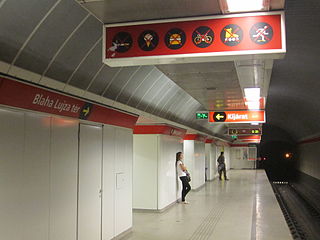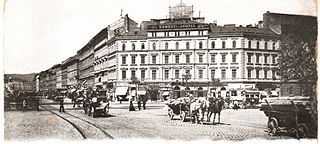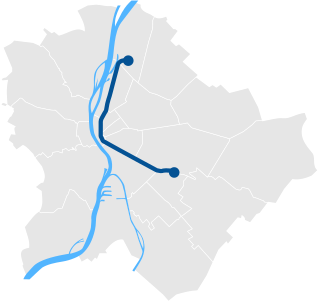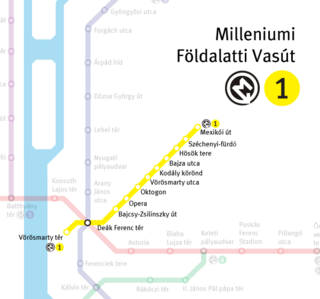
Nagykörút, also Grand Boulevard or Great Boulevard, is one of the most central and busiest parts of Budapest, a major thoroughfare built by 1896, Hungary's Millennium. It forms a semicircle connecting two bridges of the Danube, Margaret Bridge on the north and Petőfi Bridge on the south. Usually the part inside and around this semicircle is counted as the city centre of Budapest.

Kiskörút or Small Boulevard is a major thoroughfare in Budapest. It forms an incomplete semicircle between Deák Square and Fővám Square. It is the border of the southern part of District 5, the innermost district of Pest. As opposed to Nagykörút, it only touches the Danube at its southern end.

The Budapest Metro is the rapid transit system in the Hungarian capital Budapest. Opened in 1896, it is the world's second oldest electrified underground railway after the City and South London Railway of 1890, now a part of London Underground, and the third oldest underground railway with multiple stations, after the originally steam-powered Metropolitan Railway, now a part of London Underground (1863), and the Mersey Railway, now part of Merseyrail in Liverpool (1886).

The Deák Ferenc square, named for Ferenc Deák, is a major intersection and transport junction in Budapest. Károly körút, Bajcsy-Zsilinszky út, Király utca, Deák Ferenc utca, and Harmincad utca converge here. Three lines of the Budapest Metro each converge on the station under the square.

Vörösmarty tér or Vörösmarty square is a public square in the Budapest city centre at the northern end of Váci utca.

Kálvin tér is a major square and intersection in the city center of Budapest, the capital of Hungary. It was named after the French Protestant Reformer John Calvin due to the large Reformed Church located there.

Széll Kálmán tér is a square in Budapest. It is one of the city's busiest transport interchanges, which is served by a station on Metro line 2, tram lines 4, 6, 17, 56, 56A, 59, 59A, 59B, 61 and bus lines 5, 16, 16A, 21, 21A, 22, 22A, 39, 91, 102, 116, 128, 129, 139, 140, 140A, 142, 149, 155, 156, 222.

Blaha Lujza tér is a station of the M2 (East-West) line of the Budapest Metro. It is a major transport junction. The station was opened on 2 April 1970 as part of the inaugural section of Line M2, between Deák Ferenc tér and Örs vezér tere.

Oktogon is one of Pest's major intersections, located at the junction of the Grand Boulevard and Andrássy Avenue in Budapest, Hungary. This junction, one of the city's most important, is named for its octagonal shape.

Astoria is the colloquial, unofficial name of a major road intersection in the Budapest city centre and it can also refer to a station of the M2 metro line. It is named after Grand Hotel Astoria at its corner.

Móricz Zsigmond körtér is a square in Budapest, Hungary.

Ferenciek tere is a station on the M3 (North-South) line of the Budapest Metro located under the eponymous square in the Downtown. It is an important junction, as several bus lines from Buda pass through or terminate here. It is also the station closest to the geographical city centre of Budapest. The station's name was Felszabadulás tér before 1990.

Deák Ferenc tér is a transfer station on the M1, M2, and M3 lines of the Budapest Metro. It is located under Deák Ferenc square in central Budapest, the capital city of Hungary. Owing to its direct transfer connection between three out of the four metro lines Budapest has and its downtown location, it is one of the busiest stations in the system.

Hősök tere is a station of the yellow M1 line of the Budapest Metro. Formerly called Aréna út station, it lies under Hősök tere at the outer end of Andrássy Avenue.

Astoria is a station of the M2 (East-West) line of the Budapest Metro, under the eponymous square, Astoria. The station was renovated from 2003 to 2004. It was opened on 2 April 1970 as part of the inaugural section of Line M2, between Deák Ferenc tér and Örs vezér tere.

Line 3 is the third and longest line of the Budapest Metro. It runs in a general north-south direction parallel to the Danube on the Pest side, roughly following Váci út south from Újpest to the city center, then following the route of Üllői út southeast to Kőbánya-Kispest. Its daily ridership is estimated at 500,000. Like metro line M1, it does not serve Buda.

Line 1 is the oldest line of the Budapest Metro, it was built from 1894 to 1896. It is known locally as "the small underground", while the M2, M3 and M4 are called "metró". It was the first underground on the European mainland, and the world's third oldest underground after the London Underground and The Glasgow Subway.


















